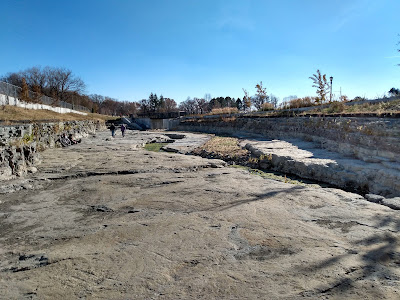I seem to have missed doing a
hyolith post
last year, which is really a shame and is all on me. Honestly, where else are
you going to get the latest information on hyoliths? Social media? Cable news?
Public radio? No, of course not! This is really a public service I'm running
here, and you'll thank me for it someday. With that out of the way, what's
been going on in the world of hyoliths over the past couple of years? A few
thoughtfully curated highlights:
If you've ever spent time looking at the origins and relationships of
gastropods, you'll be familiar with the seemingly endless debates about
whether such-and-such is a gastropod or something that just happens to have a
shell that looks like a snail shell (like
monoplacophorans,
helcionelloids, and maybe
bellerophonts). We've had a bit of that with the local
snail-oids, although by the Late Ordovician most of the hard cases had been cleared
out. Down in the Cambrian things are more complicated. One example is
Protowenella, an itty-bitty (smaller than 1 mm long) shell thing that
looks kind of like a
Phrygian cap. (Okay, fine, it looks like an exaggerated Smurf hat.) Is it a gastropod, a
monoplacophoran, or a helcionelloid? According to Peel (2021), it is none of
these. Instead, it is... a hyolith.
(Admittedly, the surprise you are feeling is probably tempered by the fact
that this is a post about hyoliths, so it wouldn't have made sense for it to be a
chiton or graptolite or something.)
Peel based his conclusion on the presence of a bilaterally symmetric operculum
(a mineralized cap that covers the shell aperture) with features
consistent with a hyolith origin. Gastropods frequently have opercula, but
they aren't symmetric, and hyoliths are the only thing known to have had
opercula in the Cambrian. If this referral is accurate, it would be something of an
unexpected expansion of hyolith morphological talents. Hyoliths, of course,
are famous for having long triangular shells with triangular cross-sections,
whereas Protowenella as mentioned looks like a curled-over pointed hat.
Now let's turn from something that doesn't look like a typical hyolith but has
something that *is* typical, to something that looks like a typical hyolith
but is missing something expected. Hyoliths are generally divided into two
groups, the orthothecids and hyolithids. Orthothecids showed up first and have
a flat, retracting operculum (rather than the more complex operculum of
hyolithids) and no helens (the paired spiny appendages that make hyolithids
look kind of like they have wide spindly mustaches). It turns out that there
are some hyoliths with hyolithid anatomy except for no helens. Liu et al.
(2022) examined one such example, "Ambrolinevitus" ventricosus,
an early Cambrian form from China (which they moved to Paramicrocornus,
also known to lack helens). The implication is that the hyolithid body shape
evolved before helens. Therefore, whatever ecological specialization was held
by hyolithids over their earlier cousins, it was underway before helens
appeared.
Finally, I leave you with Sun et al. (2021), a description of some beautifully
preserved Cambrian hyoliths from China. Assigned to the new species
Novakotheca weifangensis, they're small (less than 2 cm at most, although
some have even smaller brachiopods attached) and pretty typical in shape. The
neat thing about them is the preservation of mineralized soft parts of the
digestive tract, interpreted as including a pharynx, esophagus, stomach,
U-shaped intestine, and possible digestive gland. The anatomy is more complex
than previously thought, and suggests that at least some hyoliths were not
simply filter feeders.
References
Liu, F., C. B. Skovested, T. P. Topper, and Z. Zhang. 2022.
Hyolithid-like hyoliths without helens from the early Cambrian of South
China, and their implications for the evolution of hyoliths. BMC Ecology and Evolution 22: article 64. doi:10.1186/s12862-022-02022-9.
Peel, J. S. 2021.
In-place operculum demonstrates that the Middle Cambrian
Protowenella is a hyolith and not a mollusc. Alcheringa: An Australasian Journal of Palaeontology 45(4):385–394. doi:10.1080/03115518.2021.2004225.
Sun H., Sun Z., and Zhao F. 2021. Exceptionally preserved hyolithids from the
middle Cambrian of north China. Geological Magazine 158(11):1951–1959. doi:10.1017/S0016756821000510.





